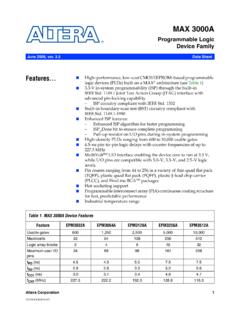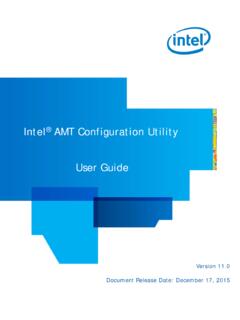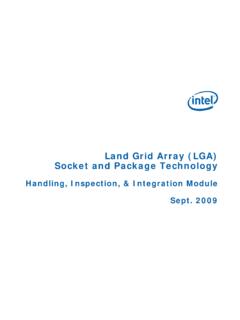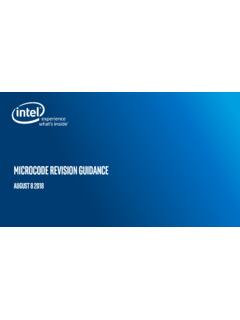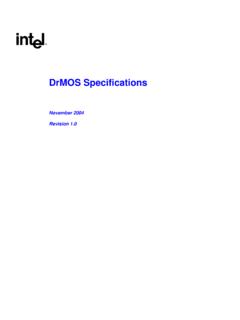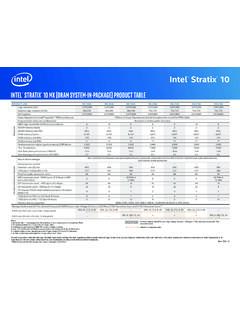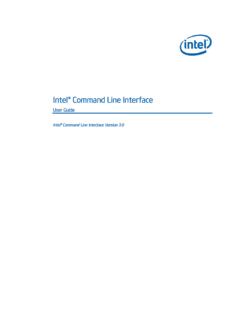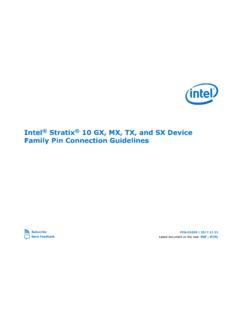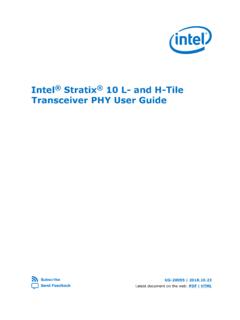Transcription of PCI-SIG SR-IOV Primer - Intel
1 321211-002 Revision January 2011 PCI-SIG SR-IOV Primer An Introduction to SR-IOV Technology Intel LAN Access Division PCI-SIG SR-IOV Primer 321211-002 2 Revision January 2011 Legal NFORMATION IN THIS DOCUMENT IS PROVIDED IN CONNECTION WITH Intel PRODUCTS. NO LICENSE, EXPRESS OR IMPLIED, BY ESTOPPEL OR OTHERWISE, TO ANY INTELLECTUAL PROPERTY RIGHTS IS GRANTED BY THIS DOCUMENT. EXCEPT AS PROVIDED IN Intel 'S TERMS AND CONDITIONS OF SALE FOR SUCH PRODUCTS, Intel ASSUMES NO LIABILITY WHATSOEVER, AND Intel DISCLAIMS ANY EXPRESS OR IMPLIED WARRANTY, RELATING TO SALE AND/OR USE OF Intel PRODUCTS INCLUDING LIABILITY OR WARRANTIES RELATING TO FITNESS FOR A PARTICULAR PURPOSE, MERCHANTABILITY, OR INFRINGEMENT OF ANY PATENT, COPYRIGHT OR OTHER INTELLECTUAL PROPERTY RIGHT.
2 Intel products are not intended for use in medical, life saving, life sustaining, critical control or safety systems, or in nuclear facility applications. Intel may make changes to specifications and product descriptions at any time, without notice. Intel Corporation may have patents or pending patent applications, trademarks, copyrights, or other intellectual property rights that relate to the presented subject matter. The furnishing of documents and other materials and information does not provide any license, express or implied, by estoppel or otherwise, to any such patents, trademarks, copyrights, or other intellectual property rights.
3 Designers must not rely on the absence or characteristics of any features or instructions marked reserved or undefined. Intel reserves these for future definition and shall have no responsibility whatsoever for conflicts or incompatibilities arising from future changes to them. Intel processor numbers are not a measure of performance. Processor numbers differentiate features within each processor family, not across different processor families. This document as well as the software described in it is furnished under license and may only be used or copied in accordance with the terms of the license.
4 The information in this manual is furnished for informational use only, is subject to change without notice, and should not be construed as a commitment by Intel Corporation. Intel Corporation assumes no responsibility or liability for any errors or inaccuracies that may appear in this document or any software that may be provided in association with this document. Except as permitted by such license, no part of this document may be reproduced, stored in a retrieval system, or transmitted in any form or by any means without the express written consent of Intel Corporation.
5 Contact your local Intel sales office or your distributor to obtain the latest specifications and before placing your product order. Copies of documents which have an ordering number and are referenced in this document or visit Intel 's website at Intel and Intel logo are trademarks or registered trademarks of Intel Corporation or its subsidiaries in the United States and other countries. *Other names and brands may be claimed as the property of others. Copyright 2008-2011. Intel Corporation. All Rights Reserved. 321211-002 PCI-SIG SR-IOV Primer Revision 3 January 2011 Revisions Date Revision Description April 2008 Initial release.
6 Confidential. December 2008 Confidential status removed. January 2011 Updated Material. PCI-SIG SR-IOV Primer 321211-002 4 Revision January 2011 Contents 1 Introduction .. 5 2 Background .. 6 Virtualization Trends .. 6 I/O Virtualization Goals .. 6 I/O Sharing Approaches .. 6 Software-Based Sharing .. 7 Drawbacks to Software-Based Sharing .. 7 Direct Assignment .. 9 Drawbacks to Direct Assignment .. 10 3 PCI-SIG Single Root I/O Virtualization and Sharing .. 11 SR-IOV Goals .. 13 SR-IOV Overview .. 13 4 Related Technologies.
7 15 Alternative Routing-ID Interpretation (ARI) .. 15 Address Translation Services (ATS) .. 16 Intel Virtualization Technology for Directed I/O ( Intel VT-d) .. 17 Access Control Services (ACS) .. 18 5 Eco-System Requirements .. 20 BIOS .. 20 Virtual Machine Monitor (VMM) .. 20 Virtual Function (VF) Creation .. 20 VF Discovery .. 21 Support for VF Driver to Physical Function Driver Communication .. 21 VF Assignment to Virtual Machines .. 21 6 Master Driver (MD) .. 22 Virtual Function Drivers .. 23 VF Driver to Master Driver Communication.
8 24 Theory of Operations .. 24 Summary .. 25 7 Additional Resources .. 27 321211-002 PCI-SIG SR-IOV Primer Revision 5 January 2011 11 IInnttrroodduuccttiioonn IBM* introduced virtualization on the VM/370 mainframe 30 years ago as a way to run multiple environments on one system. At the time, computing resources were expensive and allowing multiple environments to coexist meant that businesses didn t have to invest in a second mainframe. Today there is a different motivation driving the trend toward virtualization. With IA-based ( Intel Architecture) servers, the price structure has changed so much that hardware cost is no longer the issue.
9 Bigger problems are physical space in the data center, power/cooling costs, and management. The performance of the IA-based servers has also increased to a point where there is a large amount of idle capacity. With virtualization, IT departments can utilize that spare capacity rather than adding a new physical server to support a new environment. Figure 1. Common Virtualized Environment Adding the virtualization layer introduces overhead that consumes some of the idle capacity. There has been significant effort in the computing industry to address this overhead.
10 Intel has introduced a set of processor, chipset and Ethernet Controller enhancements defined under Intel Virtualization Technology ( Intel VT) toward this end. Intel VT improves the performance, efficiency, and robustness of virtualized platforms. The latest trend is to develop complementary mechanisms in the I/O subsystem. The PCI-SIG * has developed the Single Root I/O Virtualization Specification ( ) to address sharing of I/O devices in a standard way. PCI-SIG SR-IOV Primer 321211-002 6 Revision January 2011 22 BBaacckkggrroouunndd Virtualization Trends There are numerous trends in virtualization that impact the I/O Virtualization solutions: Platform performance is increasing Multi-Core CPU s are perfect for virtualization Many platforms are underutilized.
